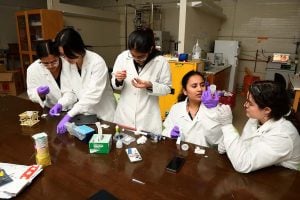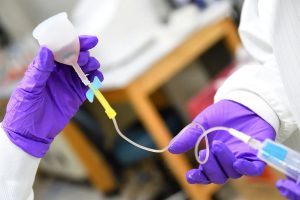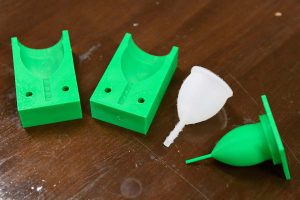
Menstrual blood contains a wealth of diagnostic biomarkers and other information often overlooked in medicine. To address this, a team of Johns Hopkins chemical and biomolecular engineering students is developing FloSync, a standardized menstrual blood collection and analysis system to aid in the understanding and diagnosis of conditions such as polycystic ovary syndrome and endometriosis. The students will present their prototype on April 29 at the Whiting School of Engineering’s Design Day, an annual event showcasing students’ solutions to real-world problems.
“Through our own experiences—or those of loved ones—with reproductive health conditions, we saw firsthand the need for a product like this. Current methods of analysis are invasive and uncomfortable, and delays are far too common,” said team member Nishtaa Modi. “Our goal would be for this product to someday be available for people to use at home.”
To create FloSync, the team adapted the design of a widely used menstrual cup, a device used to collect menstrual fluid, to enable the collection of a stable sample free of cell debris, mucus, and clots.
“Once collected, the menstrual fluid can be sent to a lab for an analysis of biomarker panels, or tested at home for protein-based biomarkers like C-reactive protein levels that can highlight inflammation,” said team member Himanshi Sharma.

FloSync’s prototype was created using a 3D printed silicone mold to form the cup, along with a 3D-printed support structure that holds a filtration system in place.
“Above the membrane is a mesh that acts as a trap for larger clots. Below this filtration system is the collection chamber, which is treated with a preservative coating. We modified a traditional vacutainer and syringe system so it ‘clicks’ with the stem of the cup for simple and convenient sample extraction,” said team member Eliana Gaitan.
The stem of the product, unlike that of a normal menstrual cup, is hollow, allowing it to serve as a collection chamber.
The team tested its prototype using readily available 40µM nylon filters (thinner than a strand of spider silk) but hopes to replace these in future designs with more water-attracting options such as hydrophilic nylon or cellulose-based membranes, which would improve flow rates.
They say that FloSync offers distinct advantages over existing products use in testing for reproductive conditions.
“There is currently only one other product on the market similar to FloSync, a sanitary pad called Q-vin, that measures for diabetes markers,” said team member Ai Omae.

“Unlike Q-vin’s pad design which can only be worn for an hour, FloSync’s menstrual cup design allows for longer wear. Most importantly, our collection method allows for clinical-grade samples and more comprehensive biomarker analysis,” said Omae.
Team members are in talks with a reproductive health startup to transfer the technology, secure a patent, and integrate it into the company’s existing products.
“We want to see FloSync enable more robust discovery trials that can open earlier and non-invasive diagnostic avenues for women’s health conditions,” said team member Alisha Parikh. “Down the line, we want to see it democratize health care data for women everywhere.”